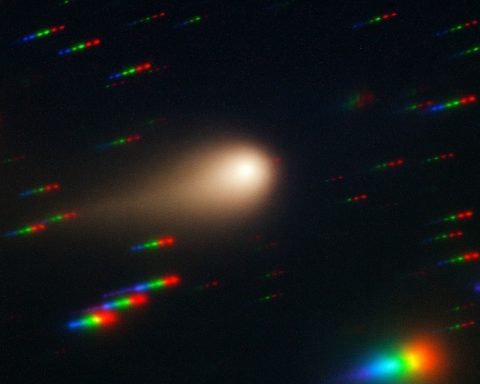Interstellar comet 3I/ATLAS continues to dominate space headlines this Sunday, 23 November 2025. New data from NASA’s Mars missions are sharpening our picture of what this visitor is made of, while a fresh claim of an “extraordinary anomaly” in its path toward Jupiter is reigniting the alien‑probe debate. At the same time, astronomers are busy debunking online rumors that the comet has broken apart.
Key updates on Comet 3I/ATLAS – 23 November 2025
- MAVEN chemistry breakthrough: A new analysis from NASA’s MAVEN Mars orbiter maps hydrogen around 3I/ATLAS and constrains its deuterium‑to‑hydrogen (D/H) ratio, giving clues to the comet’s birthplace in another star system. [1]
- Multi‑mission NASA campaign continues: Twelve NASA spacecraft – from Mars orbiters to deep‑space probes – have now imaged the comet, building a 3D picture of its coma, tail and trajectory. [2]
- No, it has not exploded: A new article explains that social‑media claims that 3I/ATLAS “broke up” at perihelion stem from confusion with a completely different comet, C/2025 K1 (ATLAS). [3]
- New “13th anomaly” claim: Harvard astrophysicist Avi Loeb argues that 3I/ATLAS’s non‑gravitational acceleration has nudged it onto a trajectory that will skim the edge of Jupiter’s gravitational “Hill sphere” in March 2026 – which he suggests could be deliberate if the object were a “mothership.” [4]
- NASA and most astronomers still say: it’s a comet, not a craft: Space agencies stress that 3I/ATLAS behaves like an active comet and poses no threat to Earth, even as debate about exotic explanations drives headlines and clicks. [5]
What is 3I/ATLAS and where is it now?
3I/ATLAS is the third confirmed interstellar object ever found, after 1I/ʻOumuamua (2017) and 2I/Borisov (2019). It was discovered on 1 July 2025 by the ATLAS survey (Asteroid Terrestrial‑impact Last Alert System), a network of robotic telescopes designed to spot potentially dangerous near‑Earth objects. [6]
Unlike ordinary comets that originate in the outer reaches of our own solar system, 3I/ATLAS arrived on a hyperbolic trajectory, moving too fast to be bound to the Sun. Its excess speed suggests it was flung out of a distant planetary system long ago and has been wandering the Galaxy for millions or even billions of years. [7]
Recent milestones along its path:
- Mars flyby: In early October 2025, 3I/ATLAS swept past Mars at roughly 19 million miles (about 30 million km), close enough for several Mars‑orbiting spacecraft – and even the Perseverance rover on the surface – to image it. [8]
- Current distance: As of this weekend, the comet is roughly 190 million miles (~307 million km) from Earth and bright enough to be recorded by professional and advanced amateur telescopes, though still faint visually. [9]
- Closest approach to Earth: 3I/ATLAS is expected to pass at about 170 million miles (≈270 million km) in mid‑December 2025, never coming anywhere near a collision course. [10]
- On toward Jupiter: After leaving Earth’s neighborhood, it will cross the orbit of Jupiter in March 2026, then head back into the depths of interstellar space, never to return. [11]
NASA and ESA repeatedly emphasize that 3I/ATLAS poses no danger to Earth. The scientific rush is not about planetary defense this time – it’s about squeezing every possible bit of data out of a once‑in‑a‑lifetime interstellar visitor before it disappears. [12]
MAVEN’s big reveal: what the Mars orbiter just learned about the comet
The freshest hard science on 3I/ATLAS today comes from NASA’s MAVEN spacecraft, which usually studies Mars’ atmosphere. Over ten days starting 27 September 2025, MAVEN pointed its Imaging Ultraviolet Spectrograph (IUVS) at the comet while it was hidden behind the Sun from Earth’s point of view. [13]
Key results, published and reported on 23 November:
- Ultraviolet glow of hydrogen: MAVEN captured ultraviolet images showing a vast cloud of hydrogen – a coma – surrounding 3I/ATLAS. By separating hydrogen coming from the comet, from Mars, and from interplanetary space, the team could isolate the comet’s own signal. [14]
- A first handle on its D/H ratio: From those observations, researchers derived an upper limit on the deuterium‑to‑hydrogen ratio in the comet’s water – a key “chemical fingerprint” used to compare 3I/ATLAS with comets in our own solar system and to infer the kind of protoplanetary disk it formed in. [15]
- Complement to earlier detections: Earlier in the year, NASA’s Neil Gehrels Swift Observatory detected hydroxyl (OH), a by‑product of water, in the comet, confirming that water ice is sublimating from its surface. MAVEN’s new data builds on that, mapping hydrogen and OH in more detail. [16]
Together with images from Mars Reconnaissance Orbiter (HiRISE), Perseverance, and a suite of heliophysics missions like STEREO, SOHO and PUNCH, MAVEN’s results slot into a broader NASA effort to observe 3I/ATLAS from multiple vantage points across the solar system. [17]
For planetary scientists, these measurements are gold: if the comet’s D/H ratio or other chemical signatures differ strongly from solar‑system comets, that would be direct evidence that planetary systems elsewhere can produce very different kinds of icy bodies.
ATLAS, the discovery survey – and why 3I/ATLAS has not broken apart
A separate article published today takes aim at one of the more persistent rumors swirling around the comet: that 3I/ATLAS “exploded” or fragmented when it passed closest to the Sun (perihelion). [18]
Universe Space Tech’s explainer on the ATLAS survey – the robotic telescope network that first spotted the interstellar comet – points out that:
- The widely shared “break‑up” story actually refers to another object, C/2025 K1 (ATLAS), a completely different comet discovered by the same observing system and now showing signs of fragmentation. [19]
- Because both comets include “ATLAS” in their names, social media and some headlines conflated the two, leading many readers to think the interstellar object had shattered. In reality, 3I/ATLAS remains intact in current images. [20]
The same article uses the confusion as a springboard to describe how ATLAS works: relatively modest telescopes scanning the sky repeatedly to catch faint specks of light in motion, originally built as an impact‑warning system but now also prolific at finding comets, including interstellar ones. [21]
Bottom line for today: if you’ve seen posts claiming that “the alien comet blew up,” they’re about the other ATLAS comet, not 3I/ATLAS.
NASA’s official view vs Avi Loeb’s “extraordinary anomaly”
The mainstream picture: a very weird, but natural, comet
Over the last week – and reiterated in coverage updated today – NASA and most of the professional astronomy community have stuck to a consistent message:
- 3I/ATLAS is actively outgassing gas and dust, displaying a coma, tail, and even multiple jets and an “anti‑tail” (a dust feature pointing toward the Sun) that are unusual but explainable within comet physics. [22]
- The interstellar visitor is “a comet that does comet things”, as one NASA scientist put it: it sublimates ices in sunlight, produces dust jets, and shows modest non‑gravitational accelerations – all classic comet behavior. [23]
- New images from multi‑mission campaigns and an Associated Press–covered press conference show the comet as a fuzzy, featureless blob at the resolution of Mars‑orbiting cameras, not a structured spacecraft, reinforcing the natural interpretation. [24]
- Officials repeatedly stress there is no evidence of alien technology and that 3I/ATLAS poses no threat to Earth, even while acknowledging that it’s an exceptionally interesting and somewhat puzzling object. [25]
Sky & Telescope’s latest science update adds that, while some non‑gravitational forces may be present, current orbit solutions are still being refined and there’s no compelling need to invoke a non‑natural explanation. [26]
The “13th anomaly”: a possible Jupiter rendezvous?
In contrast, Avi Loeb – a Harvard astrophysicist known for arguing that certain interstellar objects might be artificial – published a new Medium essay in the last 24 hours entitled “An Extraordinary New Anomaly of 3I/ATLAS.” [27]
In it, and in a separate article syndicated by inkl today, he argues that:
- Updated orbital calculations from NASA’s JPL Horizons system predict that on 16 March 2026, 3I/ATLAS will pass about 53.445 million km from Jupiter. [28]
- Jupiter’s Hill radius – the region where its gravity dominates over the Sun’s and can capture small objects – is about 53.502 million km at that time. That means the predicted closest approach lies within ~0.06 million km of the Hill radius, matching it to better than one part in a thousand. [29]
- Loeb notes that the comet’s non‑gravitational acceleration near perihelion, estimated at roughly 5×10−75 times 10^{-7}5×10−7 AU/day², would have shifted its Jupiter encounter distance by about 0.1 million km – just the amount needed to “nudge” it onto this Hill‑sphere‑skimming path. [30]
From these numbers, he infers a new “13th anomaly”: that the measured outgassing forces might amount to a fine‑tuned course correction, consistent with thrusting by a controlled spacecraft aiming to drop small probes into stable orbits around Jupiter. [31]
Loeb suggests that:
- If 3I/ATLAS were a mothership, it might use Jupiter’s Hill sphere as a convenient place to park “technological devices,” which missions like Juno or future Jupiter orbiters could, in principle, discover. [32]
- A failure to find such objects would argue against the spacecraft idea, but he says ignoring this possibility outright would be “unscientific.”
These ideas are highly speculative and remain firmly in the minority. Coverage in outlets like Futurism and The Times of India today highlights both Loeb’s insistence on keeping the alien‑craft hypothesis on the table and the pushback from NASA and many comet experts, who view his arguments as cherry‑picking oddities in what is still an evolving data set. [33]
A separate Meyka AI news digest, also published in the early hours of 23 November, underscores how this debate is spilling into broader public and even investor conversations, but reiterates that NASA’s official position is firmly in the “natural comet” camp. [34]
Reality check:
- The Jupiter‑Hill‑radius coincidence is mathematically interesting, but orbit solutions always carry uncertainties, and comets often show small, variable non‑gravitational accelerations.
- So far, no direct technosignatures or unambiguous artificial structures have been detected. Everything currently observed – jets, tails, brightness changes – can in principle arise from natural outgassing, even if some aspects are unusual. [35]
For now, the safest summary is: 3I/ATLAS is behaving like a very strange comet, and scientists disagree about how far to push that strangeness.
How to see Comet 3I/ATLAS in the sky this week
If you’d rather look at the comet than argue about it, good news: 3I/ATLAS has emerged from behind the Sun and is creeping higher into the pre‑dawn sky.
Guides from BBC Sky at Night and Sky & Telescope outline the observing basics: [36]
- When to look:
- Best shortly before dawn, roughly between local 4–6 a.m., depending on your location and date, while the sky is still dark but the comet is sufficiently high above the horizon.
- Where to look:
- The comet is climbing through Virgo in the southeastern sky on mornings around 23–25 November, sliding toward the star Eta Virginis according to current finder charts.
- How bright is it?
- Expect it to be around magnitude ~13 – far too faint to see with the naked eye or ordinary binoculars. You’ll need a medium‑to‑large amateur telescope (20–25 cm aperture or more) and a very dark sky.
- Practical tips:
- Use an up‑to‑date sky‑charting app or software that can import the latest comet ephemeris.
- Let your eyes adapt to the dark, use averted vision, and be patient – in most setups, 3I/ATLAS will appear as a small, diffuse smudge rather than a dramatic tailed spectacle.
Even if you can’t see it yourself, many observatories and remote‑telescope projects (like the Virtual Telescope Project) are livestreaming views, giving the public a chance to follow this interstellar wanderer’s progress. [37]
What happens next? December flyby and the road to Jupiter
Looking ahead from today’s vantage point:
- Mid‑December 2025 – Earth’s closest view
As 3I/ATLAS reaches its closest approach to Earth at ~170 million miles, both professional and amateur telescopes will get their best shot at studying its nucleus, jets and tail in detail. NASA’s space telescopes, including Hubble, James Webb, and missions like Lucy and Psyche, are planning additional observations. [38] - New chemistry and structure results expected
With MAVEN’s hydrogen mapping, Mars‑orbiter HiRISE imaging, heliophysics missions’ near‑Sun views, and deep infrared spectroscopy from space telescopes, scientists hope to pin down:- The comet’s size and shape
- The detailed mix of ices and dust (water, CO₂, CO and other volatiles)
- How its jets and multiple tails are structured and driven [39]
- March 2026 – the Jupiter encounter
On 16 March 2026, 3I/ATLAS is projected to skim the edge of Jupiter’s sphere of influence. Routine monitoring of Jupiter by missions like Juno and ground‑based telescopes will likely continue, both for normal science and – thanks to Loeb’s publicity – in case anything genuinely odd shows up in Jupiter’s environment after the passage. [40]
Whatever happens, 3I/ATLAS is already changing our understanding of interstellar comets. It’s giving scientists:
- a rare chemical sample from beyond the solar system,
- a live test of how well we can coordinate spacecraft scattered across the solar system to observe a fast‑moving target, and
- a case study in how science, speculation and social media intersect when something truly weird shows up in our skies.
For now, the most grounded takeaway on 23 November 2025 is this:
3I/ATLAS remains an intact, highly active interstellar comet.
We’re learning more about its chemistry and orbit every day, and while bold hypotheses about alien motherships grab headlines, the evidence on the table still fits comfortably – if intriguingly – within the realm of extreme but natural comet behavior.
References
1. www.skyatnightmagazine.com, 2. science.nasa.gov, 3. universemagazine.com, 4. avi-loeb.medium.com, 5. www.wilx.com, 6. science.nasa.gov, 7. www.inkl.com, 8. science.nasa.gov, 9. www.wilx.com, 10. science.nasa.gov, 11. science.nasa.gov, 12. science.nasa.gov, 13. www.skyatnightmagazine.com, 14. www.skyatnightmagazine.com, 15. www.skyatnightmagazine.com, 16. www.skyatnightmagazine.com, 17. science.nasa.gov, 18. universemagazine.com, 19. universemagazine.com, 20. universemagazine.com, 21. universemagazine.com, 22. skyandtelescope.org, 23. skyandtelescope.org, 24. www.wilx.com, 25. www.wilx.com, 26. skyandtelescope.org, 27. avi-loeb.medium.com, 28. avi-loeb.medium.com, 29. avi-loeb.medium.com, 30. avi-loeb.medium.com, 31. avi-loeb.medium.com, 32. avi-loeb.medium.com, 33. futurism.com, 34. meyka.com, 35. skyandtelescope.org, 36. www.skyatnightmagazine.com, 37. skyandtelescope.org, 38. science.nasa.gov, 39. science.nasa.gov, 40. avi-loeb.medium.com










